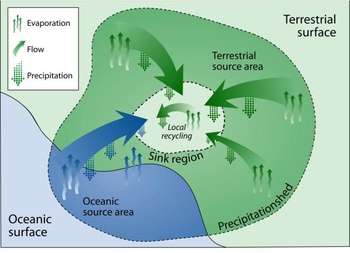Precipitationshed
A precipitationshed is the upwind ocean and land surface that contributes evaporation to a given, downwind location's precipitation. The concept has been described as an "atmospheric watershed".[1] The concept itself rests on a broad foundation of scholarly work examining the evaporative sources of rainfall.[2][3][4] Since its formal definition, the precipitationshed has become an element in water security studies,[5] examinations of sustainability,[6] and mentioned as a potentially useful tool for examining vulnerability of rainfall dependent ecosystems.[7]

Concept
In an effort to conceptualize the recycling of evaporation from a specific location to the spatially explicit region that receives this moisture, the precipitationshed concept was expanded to the evaporationshed. This expanded concept has been highlighted as particularly useful for providing a spatially explicit region for examining the impacts of significant land-use change, such as deforestation, irrigation, or agricultural intensification.[8][9]
See also
References
- ↑ P. W. Keys; et al. (2012). "Analyzing precipitationsheds to understand the vulnerability of rainfall dependent regions" (PDF). Biogeosciences. 9: 733–746. doi:10.5194/bg-9-733-2012.
- ↑ R. Koster; et al. (February 1986). "Global sources of local precipitation as determined by the Nasa/Giss GCM". Geophysical Research Letters. 13 (2): 121–124. Bibcode:1986GeoRL..13..121K. doi:10.1029/GL013i002p00121.
- ↑ E.A.B. Eltahir and R.L. Bras (July 1994). "Precipitation recycling in the Amazon basin". Quarterly Journal of the Royal Meteorological Society. Part A. 120 (518): 861–880. doi:10.1256/smsqj.51805.
- ↑ P.A. Dirmeyer and K.L. Brubaker (27 August 1999). "Contrasting evaporative moisture sources during the drought of 1988 and the flood of 1993". Journal of Geophysical Research: Atmospheres. 104 (D16): 19383–19397. Bibcode:1999JGR...10419383D. doi:10.1029/1999JD900222.
- ↑ H. Wheater and P. Gober (13 November 2013). "Water security in the Canadian Prairies: science and management challenges". Phil. Trans. R. Soc. A. 371 (2002 20120409): 20120409. doi:10.1098/rsta.2012.0409.
- ↑ J.Rockström; et al. (2014). Water Resilience for Human Prosperity. Cambridge University Press. ISBN 9781107024199.
- ↑ R.Mahmood; et al. (March 2014). "Land cover changes and their biogeophysical effects on climate". International Journal of Climatology. 34 (4): 929–953. doi:10.1002/joc.3736.
- ↑ P. W. Keys; et al. (2014). "Variability of moisture recycling using a precipitationshed framework" (PDF). Hydrology and Earth System Sciences. 18: 3937–3950. doi:10.5194/hess-18-3937-2014.
- ↑ R.J. van der Ent et al. (2013). "Oceanic sources of continental precipitation and the correlation with sea surface temperature". Water Resources Research. 49 (7): 3993–4004. doi:10.1002/wrcr.20296.
External links
- Stockholm Resilience Centre Whiteboard talk series
- CABI: Precipitationsheds - a new concept for water science
- Water Resilience for Human Prosperity